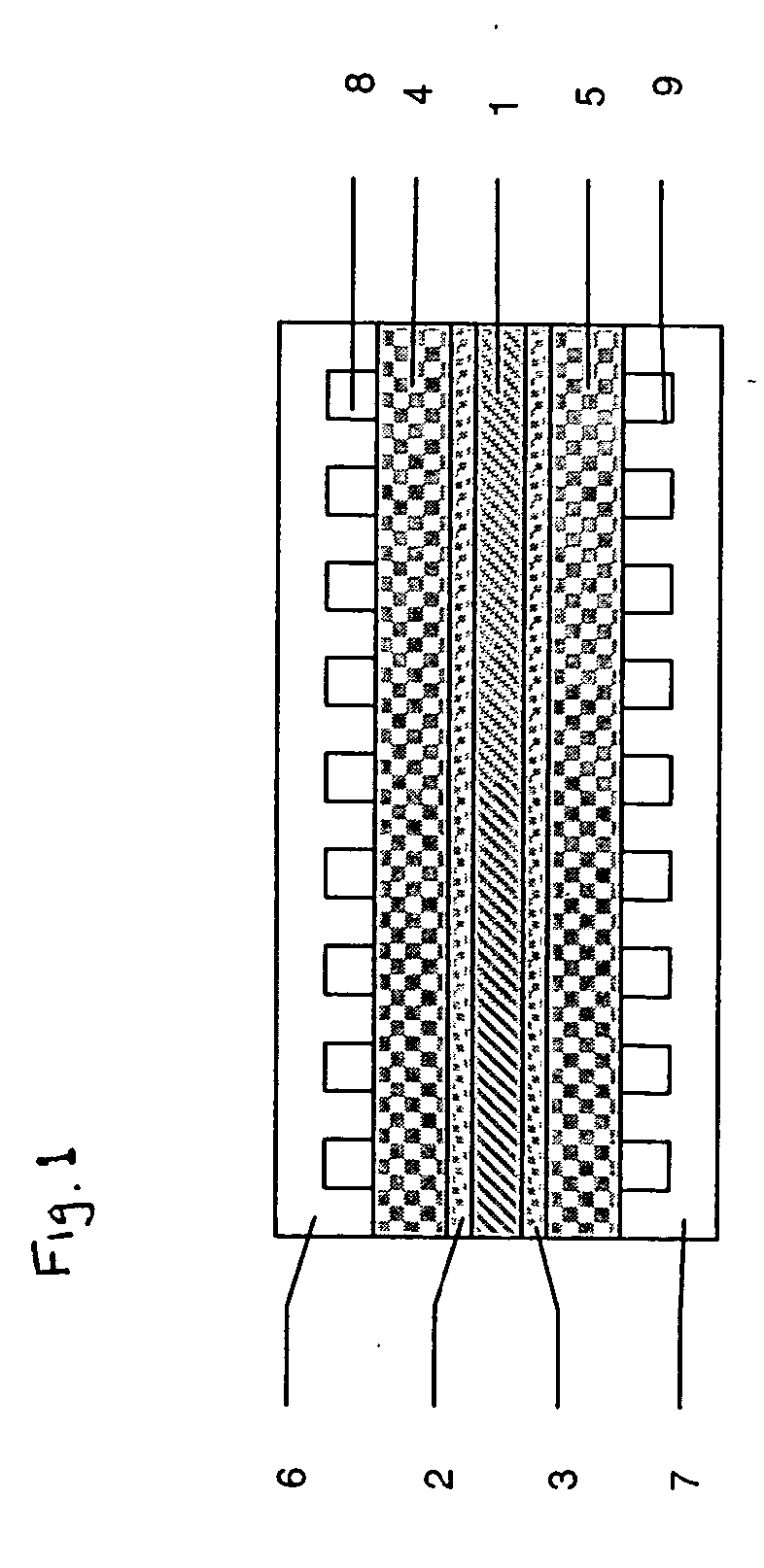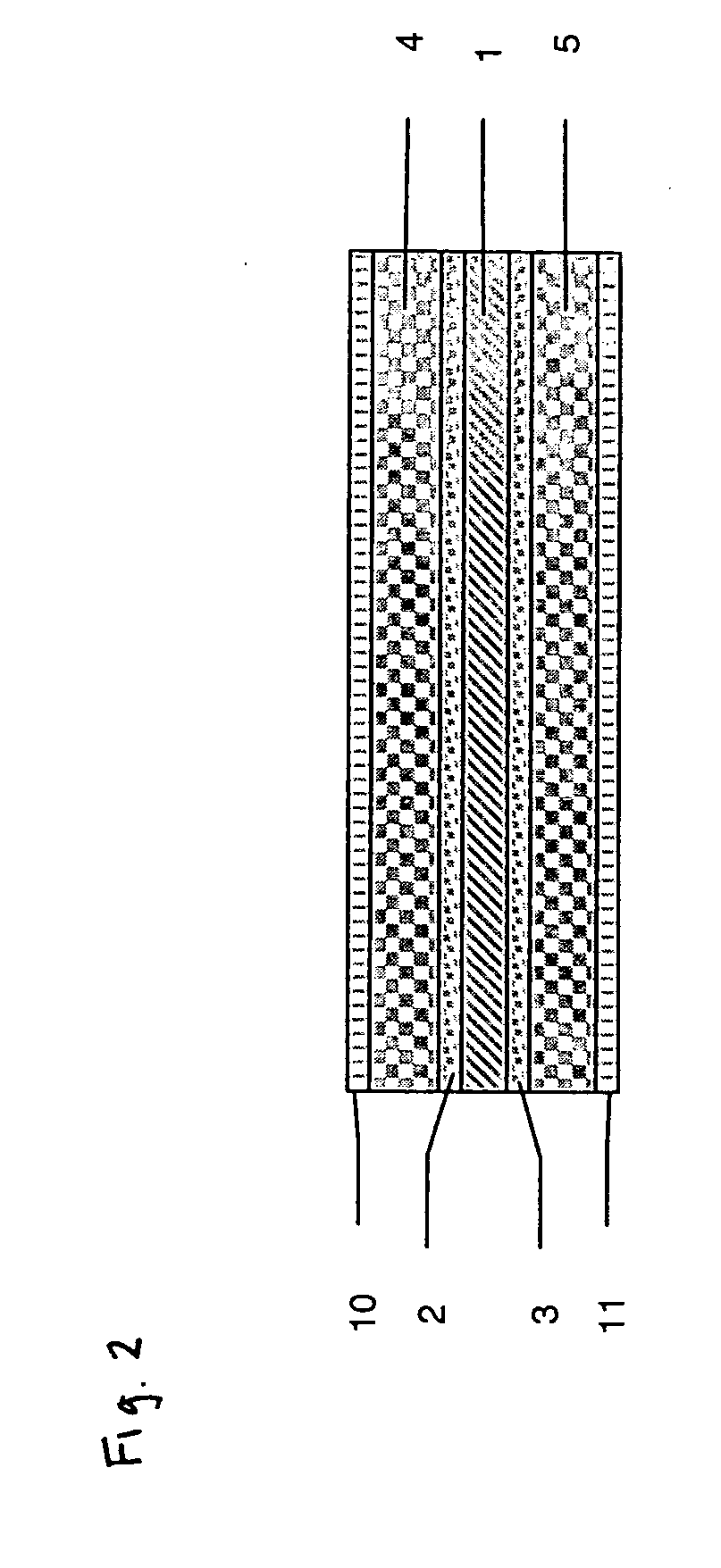Thin film fuel cell assembly
a fuel cell and thin film technology, applied in the direction of fuel cells, electrochemical generators, electrical equipment, etc., can solve the problems of increasing the weight and size increasing and increasing the cost of the fuel cell, so as to reduce the contact resistance of the fuel cell and reduce the weight and size. , the effect of compact siz
- Summary
- Abstract
- Description
- Claims
- Application Information
AI Technical Summary
Benefits of technology
Problems solved by technology
Method used
Image
Examples
example 1
[0030] A 5 cm×5 cm highly conductive and high polymer content gas diffusion layer is laminated to a 5 cm×5 cm titanium film (porous current collector) under pressure of 200 B and temperature of 160° C. for 1 minute. A catalyst ink with a Pt loading of 0.4 mg / cm2 is coated to the gas diffusion layer. The laminated and catalyst coated material is cut into four pieces, each with a size of 2.5 cm×2.5 cm. A 5.5 cm×2.5 cm proton exchange membrane is placed in between the two pieces and laminated at below 200 Bar and at a temperature of 160 C for 2 minutes. A membrane electrode assembly and current collector sub-unit with two cells is produced.
[0031] The sub-unit is placed in two pieces of plastics frame and laminated. Then a non-porous plastic film is further laminated to the anode side of the sub-unit and a hydrogen inlet needle and a hydrogen outlet needle are installed on the fuel cell unit.
[0032] After supplying hydrogen to the fuel cell and connecting it to a load, a voltage of 1.4...
example 2
[0033] A 2.5 cm×2.5 cm CCM is sandwiched between two 2.5 cm×2.5 cm highly conductive and high polymer content gas diffusion layers, and two 2.5 cm×2.5 cm titanium film (porous current collector) are disposed on the outer sides of both gas diffusion layers. The entire five layers are laminated under a pressure of 200 Bar and at a temperature of 160° C. for 2 minutes, to form a membrane electrode assembly and current collector sub-unit.
[0034] The sub-unit is placed in two pieces of plastics frame and laminated. Then a non-porous plastics film is further laminated to the anode side of the sub-unit and a hydrogen inlet needle and a hydrogen outlet needle are installed on the fuel cell unit.
[0035] After supplying hydrogen to the fuel cell and connecting it to a load, a voltage of 0.7 and current of 0.15 A are observed.
[0036]FIG. 4 shows double cell unit. It includes membrane 1, catalyst layers 2, 3 on both sides of the membrane, gas diffusion layers 4, 5 on sides of both catalyst laye...
PUM
| Property | Measurement | Unit |
|---|---|---|
| melting temperature | aaaaa | aaaaa |
| temperature | aaaaa | aaaaa |
| size | aaaaa | aaaaa |
Abstract
Description
Claims
Application Information
 Login to View More
Login to View More - R&D
- Intellectual Property
- Life Sciences
- Materials
- Tech Scout
- Unparalleled Data Quality
- Higher Quality Content
- 60% Fewer Hallucinations
Browse by: Latest US Patents, China's latest patents, Technical Efficacy Thesaurus, Application Domain, Technology Topic, Popular Technical Reports.
© 2025 PatSnap. All rights reserved.Legal|Privacy policy|Modern Slavery Act Transparency Statement|Sitemap|About US| Contact US: help@patsnap.com



